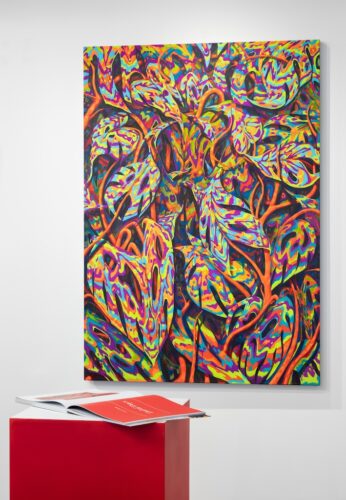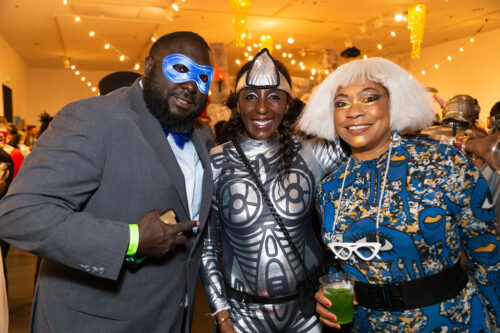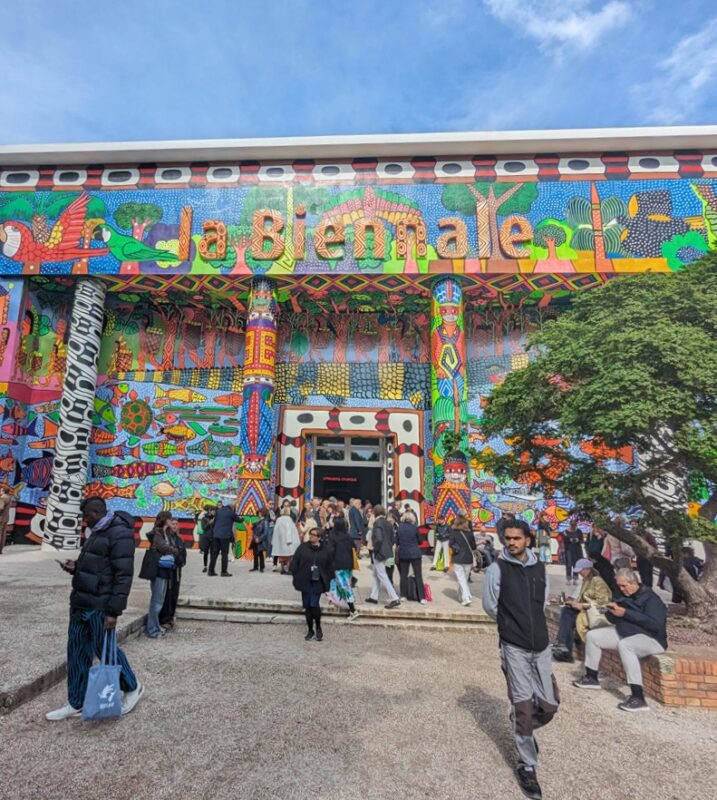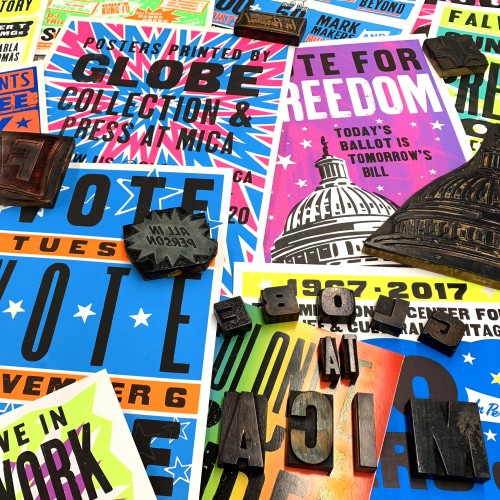Cara: Building on that, what can we do? We can vote and represent ourselves that way. We can volunteer for campaigns and go door to door like Erin’s doing right now, which we appreciate. That’s real labor that we all benefit from. But I’m curious, Erin, from your perspective also, of being inside the Baltimore political machine, [laugh], you’ve seen things that the rest of us are never going to see.
It is a political act to make art in this world in any place, in any space. Sometimes it’s a political act to refuse to show your work in a specific context, like the protest we’re seeing in Venice right now. But for you personally, Erin, where do you see this going? How do you draw your strength as a woman and lend that strength to other women as well?
Erin: Man, I should’ve known we would have such heavy conversion, Cara Ober! [laughter] I don’t know… I don’t know how to show up any other way than just being who I am. I think that all artists bring what they’ve got to the table, and that all the art that we make is an extension of ourselves.
In that regard, everything that I make is something that I’ve experienced, something that I’ve observed, and something that should be talked about. I don’t know if I think about my work as political… I didn’t think about these bedrooms as political. It was just a thing that felt important to me. But I think that inherently, certain acts are political, just existing is sometimes political, especially existing with the politics of right now. I often, especially during election seasons, have very little hope for better things, but I find myself just having to be more mindful of thinking in a more positive way.
Right now I am door knocking one day a weekend, helping to get my husband, Ryan Dorsey reelected, because he does work that is incredibly important. I have so many conversations with strangers about all kinds of things! Things you would not want to talk to your parents about [laughter] at a holiday meal.
People say, don’t talk about politics with friends and family in general, because it’s too divisive of a thing. But, I’m walking up to people’s doors and I’m knocking on them, and I’m trying to have the most political conversation possible, asking who are you voting for? And I’m trying to get them to vote for somebody that I want them to vote for. In doing that, I have to talk about things that we disagree on and abortion has not been one of those things, but things that matter so much less than those things like bike lanes, [laughter].
I have SO MANY conversations about bike lanes, and I’m a person who bikes, so bike lanes to me are a conversation about safety and also about autonomy and not having to own a car to get around. So it’s really interesting to try to have a very calm, balanced conversation with people, which is not always possible. They’re gonna come outta the house angry and yelling… and you don’t engage with those people. You walk away, but it’s important to understand that some people might never agree with you but if you stand there long enough and you listen to what they have to say, and then you can offer them something in addition to that, not in opposition to it, you might shift their thinking a little bit.
Honestly, I have changed so many people’s minds about these bike lanes and I think that it is just a matter of, well… people say I have a very calming voice. [laughter] Maybe I’m just lulling people into agreement?
But I think that there is something very true about coming into conversations where you have a personal stake and you find a way to bring that to somebody who has no personal stake, or they don’t think that they have a personal stake, and you have to make them realize that they do, either through themselves or through their proximity. So you try to talk it out. This can happen through door knocking or you can try to do it through art and see what conversation happens.
Lynn: I think a lot of the public discourse and the media coverage of abortion often focuses on legislative change and policy change: how can we legalize our way out at the state level and federal level on the issues that we have around reproductive care and abortion care. But the work that is fundamentally important that does get sometimes lost in these broader national conversations is about the dialogue and how we are opening up to people in our networks, in our own communities with our loved ones to talk about abortion and to talk about how both personal and universal that experience is.
I talk about this statistic a lot, but one in every four women, transgender, non-binary, and birthing people, will have an abortion in their lifetime. And the impact of that is not just solely with that individual, but it also extends through their families, their loved ones, their partner, their other kids.
The decision of whether or not to have children is so fundamentally a part of life and so deeply important a decision to be able to make without interference. That type of culture shift that’s happening in a community and an individual level cannot be understated in its importance. To come back to your original question, what can artists and the arts do towards community mobilization? I’m seeing a couple of inroads and connection points. Number one, art in itself requires a suspension of disbelief and opens people up to new ideas and new experiences. And so art can be a very powerful vehicle for any type of culture shift, for that big narrative changes.
Artists are also community builders, right? Look at the space that we’re in right now, that is focused around art and building community. By having and creating those types of spaces, bringing in issues that are, maybe on a surface level unrelated, but are kind of deeply connected to our lives… Art is a reflection of life, so there are ways that we can start to make that change that’s happening outside of policy spaces, which is really fundamental because a lot of the harmful legislation that we’re seeing will have impacts and ramifications that will take years to undo.
And in the meantime, there are thousands of people, both Maryland residents and people across the country who are being denied care especially at the intersections of class, race, ability, and gender, and all of the other ways that our lived identities impact our experiences and the ways that we move through the world. So it’s really important for us to be doing that work. It’s really important to donate to your local abortion funds, as well, because part of the work that we’re doing is trying to mitigate the harm and find workarounds for people who are running up against these barriers, and these issues in real time while we’re waiting for the longer movement building work of shifting policy to happen.
Cara: I want to reiterate what Lynn said, that having abortion care be available is essential. Without it, women become second class citizens. Without the right to abortion, we are no longer equal to men. For that reason, and for many health related reasons, the right to abortion care needs to be codified into law at a federal level. This should have happened before, but it didn’t, and it needs to. Looking at this election year, what’s potentially going to happen in Maryland, which is extremely stressful to me, if OUR state turns the US Senate red. But, educating ourselves, educating others, having the conversations that need to be had, whether they make us uncomfortable or not, is essential.
Despite everything, we are lucky that we live in a country where we can protest, and we can say the things that we believe in freely–and we don’t get pushed out a window afterwards. We have something worth fighting for and defending and the other side of that is the artist’s ability to create transformative spaces of beauty. This is one reason why I wanted to show this body of work here.
Having the opportunity to gaze deeply into these pieces, they’re quite sumptuous in their detail. You can sense the love and the care that goes into them. There is real power in the details, in the tiny little idiosyncratic pill bottles and remote controls and posters, that the artist has chosen to include. We can take some audience questions now.
Audience Member 1: This is a question for Lynn. First of all, way back when I used to be a parent-child health nurse, and even when I was in nursing school, I was in New York City and it was one of the first states to liberalize their abortion law. And one of the things that happened is that when people were coming from other states seeking abortions, and very often they were later term abortion, by the way, medically, there’s a, it’s therapeutic abortion and spontaneous abortion.
Spontaneous abortion is for what we commonly call miscarriages, but there’s really no other, it’s therapeutic abortion. And I wish to some extent we would start using that as the general term because it is therapeutic for whatever reason it is therapeutic. So my point is, in your own experience now, is that what you’re seeing in people who are in a desperate situation? Maybe you could relate without naming names some of the situations that you’ve come across and how you’ve helped.
Lynn: Similar to Erin, we try to talk about universal themes, common experiences, patterns that we’re seeing, as opposed to speaking specifically about what individual clients are facing. But I think that’s a really great question. I think sometimes it can be helpful to put into context what an abortion costs, especially for people who haven’t had experience working within a medical system. In Maryland, an abortion can cost anywhere from $500 to $20,000 and up depending on how far along you are in pregnancy. So when you think about that in the context that most Americans cannot afford an unplanned expense of a thousand dollars, needing to have an abortion if it’s not covered by insurance, which we all know that insurance coverage in the US can be absolutely trash and a huge headache to deal with.
It can be a serious financial crisis that people are trying to navigate, calling abortion funds like the Baltimore Abortion Fund, and other sources of financial support to try to get together enough money to be able to afford the cost of their care. Not to mention childcare, taking time off from work without pay, all of the other things that go into accessing medical care in this country that can be really difficult. But in terms of kind of the other theme that I kind of heard coming up in your question was around travel and what that has looked like. For us in Maryland, travel to Maryland for abortion care has always been very common. Similar to what you were describing when New York legalized abortion, there are a lot of people coming there for abortion care later in pregnancy.
So as of now, Maryland and the DC area is home to three out of four clinics nationwide that are able to provide abortion care later pregnancy, including the third trimester and that’s a very specialized form of care that if you live in California or Washington state, it’s just not available where you live. So people are often coming to Maryland to go to those three clinics. Travel’s always been a big part of what we do, but I think something that often surprises people is that roughly half of our clients are Maryland residents who still cannot afford the cost of their care despite their state protected legal rights. So I think this kind of connects back to some of the themes that we were talking about earlier, that institutions and laws are not going to save us or protect us.
Rights alone are not enough to guarantee real access that is going to provide the medical care that people need. It underscores the importance of a community individuals taking care of each other and showing up for each other, whether it’s mutual aid, whether it’s abortion funds, whether it’s supporting a friend through an abortion, in whatever ways they need. That is a very broad and roundabout way of starting to scratch the surface of what that work looks like.
Audience Member 2: I’ll begin by confessing that I was raised as a Catholic and went to Catholic schools all the way through high school. So you’ll understand that that sets the stage for my question, because I believe very firmly that abortion should be available to anyone who needs or wants it and I’ve been reflecting a lot on the recent scandals in the Catholic church and sort of wondering how the church’s advocacy against abortion, which has been very, shall we say, loud [laughter], how one can justify that while recognizing the obvious question, what about all these people who, these priests, staff members, et cetera, who had sex with young girls, et cetera? Mm-Hmm. [affirmative]. How do you justify opposing their right to abortion? And I, I think because Maryland was essentially founded as a Catholic state, that it’s really a challenge. And I’m just wondering if you have any insight on that, on that issue.
Lynn: Let’s just say it flat out: religious people get abortions. Catholics get abortions, of course. Super conservative Christians get abortions, right? And so I do find that there’s a level of cognitive dissonance that is involved in the ability to, on one hand talk about and really disparage a routine form of healthcare as a moralized and stigmatized issue and also need those services at the same time. I think the common theme there, and I really love that you brought up the fact that Maryland was founded as a Catholic state because I think at the root of restrictions on abortion, it really does come down to reproductive control and coercion, which is exercised by all different types of entities that have power, whether that is state government, whether that is a religious institution.
All of this is about maintaining the status quo, maintaining systems of power, and maintaining the systems of racism and classism that are embedded in our society and all of the genderism within the institutions that are operating in this space. So, it doesn’t surprise me that there is this level of hypocrisy and I think it’s an outgrowth of the dynamics of power and control that exist both at the individual level and in the societal and universal level as well. Also, there is an organization called Catholics for Choice that advocates for abortion.
Audience Member 3: I have a question for Lynn, although Erin does persuasive voter communication, so I think this is probably something you could speak to as well. One of the things that is really exciting to me for the length of time that I’ve been involved with abortion funds is watching them grow and staff up. When I was on the board of the Lilith Fund, we had a 10 hour a week part-time contract online coordinator and now they have like 10 staff members. Some of my former students worked there and all were volunteers, and now there are employees. That to me, as a donor, is so important because if someone is doing their regular job and they get found out as being on the board of an abortion fund or a volunteer, and they can lose their job, that’s a big problem.
But you can’t lose your job for working in abortion funding because it IS your job. So one of the things that I would love to hear you speak to is what can BAF do that the other organizations in this same space can’t do? Because I often, when I do fundraising for Fund-a-Thon, I have wonderful family members and people that I know who give to local Planned Parenthood affiliates, and that’s great, and here’s why BAF is different and they need that. What are the opportunities that you have that some of the other organizations operating in similar spaces don’t have?
Lynn: I love this question and the first thing that comes to mind, and I think that you are speaking to this as well, is that they’re all important, right? The very grassroots volunteer run, more mutual aid based abortion fund is super important in the work that they do. I should take one step back here, and say that BAF has been around for 10 years. This is our 10th year anniversary, so that’s a huge milestone for us, and we’ve seen a lot of really transformative growth in the way that we operate, the way that we move through space and what we’re able to do. As an example, at BAF we hired our first full-time staff in 2021.
To give a sense of scale, in 2021 as an organization that was for most of the year, run by a super dedicated and talented board of directors who was also carrying out the day-to-day work of the organization, BAF distributed around $250,000 in financial support. We didn’t have our practical support program to do hotels and rides and other coordination, and we were really focused on getting money in and out the door for people who need it. Moving into 2020, BAF distributed around $700,000 in both abortion funding and practical support. And then last year, we hit the $1 million mark, so this is really another exciting milestone for us and absolutely needed, especially in response to the realities that people are facing.
I think it’s all necessary, whether it is BAF or Planned Parenthood, who we work really closely with who is providing the clinical piece of care, as well as some of the policy and advocacy work, smaller grassroots organizations, mutual aid, who are doing some of the interpersonal work culture shift. Honestly for BAF as a staffed organization, one of the things, that is a blessing and also limiting in some ways is that we are a 501c3, so we’re op operating within the landscape and the system of philanthropy, which can be really wonderful in that people can get a tax rate off when they donate to that. In some ways, this can limit what we can do because we can’t do advocacy like a 501c4 can. So we both have our hands tied in some ways. But we’re also taking advantage of the tax code, and adding an extra incentive for people, whether you’re a grassroots donor or whether you’re an individual who moves in circles of wealth or wealthier, to be able to undo the harms and problems that we have in our current society.
Cara: Thank you. I think that too often the arts community and the political world in Baltimore tend to be mutually exclusive. Erin is a rare distinction there, an anomaly with her direct connection to city politics, but it’s really important for people who are not necessarily artists or part of the art community or know and spend time with artists, for them to be invited into spaces where they can engage with art made by people that live in their city that are experiencing the same reality. That’s something I want you to take with you and think about, if you’re someone who is primarily in art circles or someone more in health or political circles, how do we merge and grow these circles together?
We really need and can certainly help one another. I think that artists’ number one superpower is their ability to creatively solve problems. We’re facing a lot of significant societal crises that perhaps we didn’t expect to have to be dealing with, again and again. However, artists often have the answers to these problems, or at least they can visualize what the future might look like in ways most of us can’t. As a culture, we need to continue to nurture these skills individually and value them within communities.
As we head into this year of gross political garbage [laughter] hopefully we can all offer some intelligent and enlightening discourse to others because these decisions really matter in the lives of so many people. I hope that tonight, we can all take a nugget of courage from these two individuals, and from these incredibly powerful drawings that depict women’s agency, which is honestly–in the history of humankind as far as we know–we’re just at the tip of the iceberg.
Personally, I’m happy to be alive during this time and, despite all the problems, I want to make sure that we continue to preserve the values and the rights that make this a space where we can continue to question and learn and explore and survive.
Lynn: For anyone who’s newly introduced to our work, BAF is in the middle of our big annual spring fundraiser, called Fund-a-Thon. It’s the most connected and community building fundraising campaign that we do all year and if anybody’s interested, you can talk to me, ask me questions. The two main things that we’re looking for is for folks to donate, which you can do at baltimoreabortionfund.org, or sign up as a fundraiser and mobilize your community around abortion care. We need you to have these conversations and engage in this work in that way.
The other thing that actually really came to mind while you were sharing your closing remarks is the beautiful ability of art to solve problems. I think one of the things about living in racist and oppressive systems is that it limits our imaginations for what could be and what type of world that we can live in. Art in particular is about that visioning and that creativity around what could come next. So I really, really loved that you shared that. I’ve never thought about art as problem solvers before, so that’s a new perspective for me.
Cara: I want to take a moment to thank these two individuals for being here and speaking, I want to encourage everyone to look at the art. If you’re interested in books or becoming a BmoreArt community member subscriber, we can hook you up with that. Thank you.
This exhibit closes on Thursday, April 25. To attend the public closing reception on Thursday, RSVP here!











